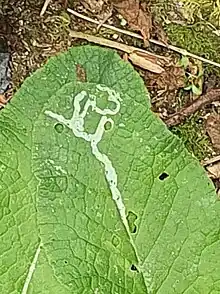| Chromatomyia primulae | |
|---|---|
 | |
| Scientific classification | |
| Domain: | Eukaryota |
| Kingdom: | Animalia |
| Phylum: | Arthropoda |
| Class: | Insecta |
| Order: | Diptera |
| Family: | Agromyzidae |
| Genus: | Chromatomyia |
| Species: | C. primulae |
| Binomial name | |
| Chromatomyia primulae (Robineau-Desvoidy, 1851)[1] | |
Chromatomyia primulae is a species of leaf-mining fly in the family Agromyzidae, of the order Diptera. The larvae mine the leaves of Primula species. The fly was described by the French physician and entomologist, Jean-Baptiste Robineau-Desvoidy in 1851 and is found in Europe.
Life history
Mines are white, long and narrow, with the frass in widely spaced black lumps. Larvae can be found in June and August-September. Mines have been recorded in the following plants: Primula bullesiana, oxlip (Primula elatior), Primula uralensis, cowslip (Primula veris) and primrose (Primula vulgaris). Pupation is within the mine, next to a vein with the anterior spiracles projecting through the epidermis. Adults fly in July[2][3]
References
- ↑ "Chromatomyia primulae (Robineau-Desvoidy, 1851)". Fauna Europaea. Retrieved 24 June 2023.
- ↑ "Chromatomyia primulae (Robineau-Desvoidy, 1851)". UKflymines. Retrieved 25 June 2023.
- ↑ Ellis, W N. "Chromatomyia primulae (Robineau-Desvoidy, 1851)". Plant Parasites of Europe. Retrieved 25 June 2023.
This article is issued from Wikipedia. The text is licensed under Creative Commons - Attribution - Sharealike. Additional terms may apply for the media files.